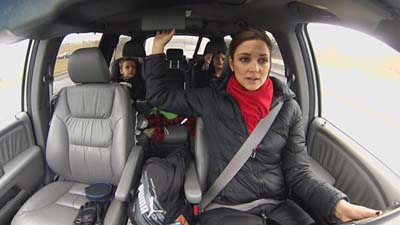 A new study that shows children cause 12 percent of the driver distraction on the road probably has a few carmakers scrambling to come up with some new technology to help address the issue.
A new study that shows children cause 12 percent of the driver distraction on the road probably has a few carmakers scrambling to come up with some new technology to help address the issue.
Amid growing concerns over the danger of cell phone usage when driving, a group of Australian researchers found that children are 12 times more distracting to the driver than talking on a cell phone while at the wheel, as reported by ABC News.
In what is believed to be the first study of its kind, the report found that the average parent takes their eyes off the road for three minutes and 22 seconds during a 16-minute trip, according to ABC.
The 2011 study, which recorded families with kids ages 1 to 8 in the car, found that the drivers did the following when kids were in the car as highlighted by Cars.Com:
- 76.4 percent of the drivers turned to look at the backseat passengers or viewed them in the rear-view mirror
- 16 percent talked to their children in the backseat
- 7 percent helped their children (by passing food and drinks)
- 1 percent played with their kids
Experts offer a number of suggestions for parents to help address the issue, as reported by “Nightline,” like pulling over to deal with situations like an infant dropping a toy −and establishing car rules for older children reminding them that you can’t reach for items when driving.
Still, considering that a parent is hardly going to pull over to grab a stuffed animal − and trying to get a kid not to scream for their juice is even less unlikely, the answer might lie in some new technology.

According to Popular Mechanics, at one point, Volkswagen was exploring a rear seat navigation system specifically for kids that displays a “time worm” eating away at the length of the route to keep them from asking that never ending question: “are we there yet?” The system depicted special scenes along the route with a cartoon character that would play games and ask the children to do in-seat exercises. The system would even go idle when the kids were napping.
A spokesperson for VW said there are no plans for developing the technology in the near future. But perhaps there’s a way to even build on the idea where if a child drops an item it would immediately activate the cartoon character on the screen to reinforce those “car rules” in a fun interactive way.
Farfetched? Maybe − especially considering that I have no real idea what goes into developing that kind of technology or the safety factors involved. More importantly, how much would it cost and would consumers be willing to pay for the extra features?
Either way, I wouldn’t be surprised to start seeing a few companies introduce some new in-car-tech safety devices focused on freeing parents more from the kids to concentrate more on the road when driving. Clearly, that “Wreck-It-Ralph” DVD isn’t enough to keep those little ones comfortable on the road, which affects everyone’s safety.
We’d be interested in hearing some of your thoughts on it all.


